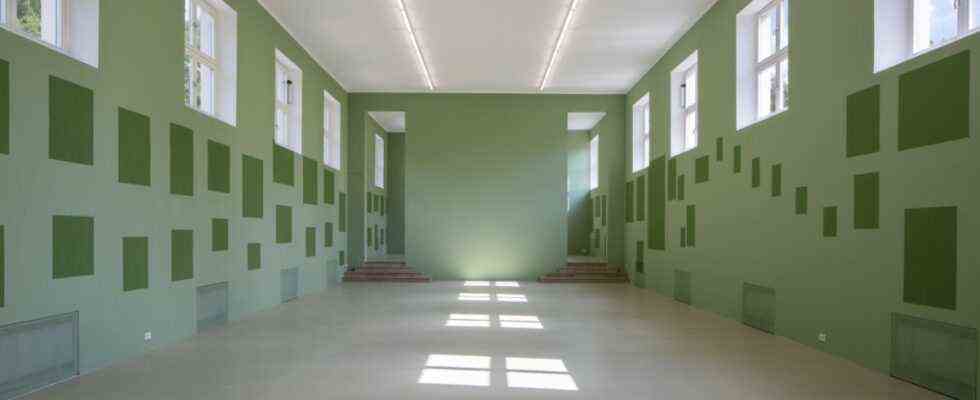This exhibition is irritating. In terms of content, because the Kunstverein’s research into its own involvement with the Nazi regime unearthed facts that had been swept under the carpet quickly and permanently after 1945. Formally, because the exhibition “No River to Cross” by Bea Schlingelhoff in that particular art association does not show any pictures, but only green spaces. Placeholder for pictures that were hung up here by the Nazis in 1937 with the intention of exposing them and their creators to the ridicule and contempt of their “Heil Hitler” screaming foot soldiers. More than 600 works of art that had been confiscated in 32 German museums, close together, in all sizes and formats. And everything was given the title “Degenerate Art”, which entered the history of Germany as a blot on art-historical incomprehension.
In these rooms, which the Kunstverein moved into in the 1950s, they hung like in a parallel universe to the “Great German Art Exhibition” in the newly built “House of German Art” – the marble temple in the English Garden, which was built on pillars and in which the Nazi Ideology infected art historians presented the works of the artists who, in their eyes, symbolized the noble art of German virtues. The Femeschau am Hofgarten, on the other hand, crammed with nothing but “un-German” art in their eyes and additionally vilified by diatribes, should make the difference all the more obvious. In truth, however, this show was a best of the art of that time.
Bea Schlingelhoff painted green fields of color where the Femeschau “Degenerate Art” hung back then
And now, 84 years later, in the same place nothing but dark green placeholders. Blind spots? Sign of oblivion? Not at all. The hanging was meticulously translated into graphic fields. Whoever wants to see can see. Only minimal support is required from the small booklet that lists the names: Corinth, Nolde, Marc, Beckmann, Kokoschka, Kirchner, Klee and others in the stairwell. Pechstein, Schmidt-Rottluff, Nay, Heckel, Grosz, Baumeister, Schlemmer, Mondrian, Kandinsky, Feininger and many more in the main hall. And the cinema in your head begins, the green placeholders are filled with images that are inextricably linked with the quintessence of classic modernism.
In order to reinforce the effect of the hanging and to cut the subject matter visually, the artist Bea Schlingelhoff has also dipped the white walls of the Kunstverein in light green. Green on green. The term “greenwashing” comes to mind immediately upon entering. That PR trick in which companies use whitewashing to give themselves a green image in order to camouflage their environmentally destructive activities. So is this about camouflage? In a way, yes. It’s about the fact that a kind of camouflage has now been blown: that of the always good, venerable Kunstverein Munich, which will celebrate its 200th anniversary in 2023.
With this preamble to the statutes, which Bea Schlingelhoff artistically implemented as a typeface in the exhibition “No River to Cross”, the current board of the Münchner Kunstverein apologizes for its behavior during the Nazi era.
(Photo: Constanza Meléndez / Courtesy the artist and Kunstverein Munich)
But this anniversary will be different. A lot has been researched in preparation for this in recent years in the art association and in the city archive. Among other things, this work brought to light a document that nobody at the Munich Art Association should be proud of. But they face their responsibility proudly and humbly under the direction of Maurin Dietrich. In 1936 the association had changed its statutes by including a paragraph in which it said: “Non-Aryans cannot become members of the association”. And the research shows something else: The cooperation with the Reich Chamber of Culture did not only take place under pressure from political authorities, “but was actively initiated and supported by the then director of the Munich Art Association, Erwin Pixis.”
Schlingelhoff, who has been artistically concerned with remembering and maintaining fascist structures for more than 20 years, then drafted a preamble. In it, the Kunstverein apologizes for its cooperation with the Nazi regime and the Reich Chamber of Culture, acknowledges its shared responsibility and asks “forgiveness” for the aforementioned amendment to the statutes. A probably unique event in a scene in which even state museums are hesitant to face their Nazi past and their post-war past, which is often brown in color. The almost 1300 current members of the association approved this amendment to the statutes with a three-quarters majority. The documents are part of the exhibition in a form artistically prepared by Schlingelhoff. The preamble and an open letter, with all interventions, changes, deletions and additions, are hanging on the staircase. A beacon – and a commitment not to sweep anything under the rug.
Bea Schlingelhoff: No River to Cross, Kunstverein München am Hofgarten, until November 21st

